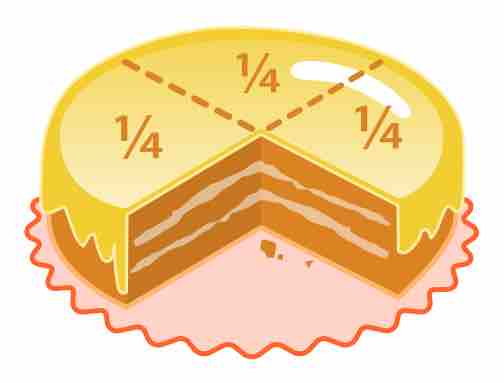A fraction represents a part of a whole. A common fraction, such as

Quarters of a cake
A cake with one-fourth removed. The remaining three-fourths are shown. Dotted lines indicate where the cake can be cut to divide it into equal parts. Each remaining fourth of the cake is denoted by the fraction
Addition
Adding Like Quantities
The first rule of adding fractions is to start by adding fractions that contain like denominators—for example, multiple fourths, or quarters. A quarter is represented by the fraction
Imagine one pocket containing two quarters, and another pocket containing three quarters. In total, there are five quarters. Since four quarters is equivalent to one (dollar), this can be represented as follows:
Adding Unlike Quantities
To add fractions that contain unlike denominators (e.g. quarters and thirds), it is necessary to first convert all amounts to like quantities, which means all the fractions must have a common denominator. One easy way to to find a denominator that will give you like quantities is simply to multiply together the two denominators of the fractions. (It is important to remember that each numerator must also be multiplied by the same value its denominator is being multiplied by in order for the fraction to represent the same ratio.)
For example, to add quarters to thirds, both types of fractions are converted to twelfths:
This method can be expressed algebraically as follows:
This method always works. However, sometimes there is a faster way—a smaller denominator, or a least common denominator—that can be used. For example, to add
Adding Fractions to Whole Numbers
What if a fraction is being added to a whole number? Simply start by writing the whole number as a fraction (recall that a whole number has a denominator of
Subtraction
The process for subtracting fractions is, in essence, the same as that for adding them. Find a common denominator, and change each fraction to an equivalent fraction using that common denominator. Then, subtract the numerators. For instance:
To subtract a fraction from a whole number or to subtract a whole number from a fraction, rewrite the whole number as a fraction and then follow the above process for subtracting fractions.
Multiplication
Unlike with addition and subtraction, with multiplication the denominators are not required to be the same. To multiply fractions, simply multiply the numerators by each other and the denominators by each other. For example:
If any numerator and denominator shares a common factor, the fractions can be reduced to lowest terms before or after multiplying. For example, the resulting fraction from above can be reduced to
To multiply a fraction by a whole number, simply multiply that number by the numerator of the fraction:
A common situation where multiplying fractions comes in handy is during cooking. What if someone wanted to "half" a cookie recipe that called for
Division
The process for dividing a number by a fraction entails multiplying the number by the fraction's reciprocal. The reciprocal is simply the fraction turned upside down such that the numerator and denominator switch places. For example:
To divide a fraction by a whole number, either divide the fraction's numerator by the whole number (if it divides simply):
or multiply the fraction's denominator by the whole number: